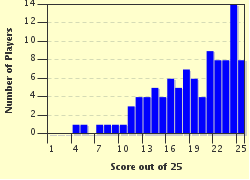Quiz Answer Key and Fun Facts
1. The letter 'A'. Who was the New Testament prophetess who spoke about Jesus "to all those who looked for redemption in Jerusalem"? (Luke 2:36-38)
2. The letter 'B' is for 'Beautiful'. What woman in the four Gospels is described as beautiful?
3. The letter 'C' is for 'Cousins'. Jesus and John the Baptist are generally perceived as cousins. Who was John's mother? (Luke 1:36)
4. The letter 'D' is for 'Dream'. What woman had a dream before Jesus was crucified and advised her husband not to cause any harm to Him? (Matthew 27:19)
5. The letter 'E' is for 'Expensive' as in 'Expensive Perfume'. What's the name of the woman who washed Jesus' feet with expensive perfume and then wiped his feet with her hair? (John 12:3)
6. The letter 'F' is for 'First'. The first person to see Jesus after His resurrection, was a woman. What was her name, as per John 20:11-18?
7. The letter 'G' is for 'Grandmother'. Mary is Jesus' mother, and going by what's contained in the Bible, there is no mention of who His grandmother is. However, going by TRADITION, the grandmother is Anne.
8. The letter 'H' is for 'Herodias'. What did she successfully convince her daughter to do? (Matthew 14:6-12)
9. The letter 'I' is for 'Insightful' and 'Industrious'. What sister of Lazarus was known for being insightful and what one was known for being industrious? (Luke 10:38-42)
10. The letter 'J' is for 'Jairus'. What was the name of Jairus' daughter who was raised from the dead by Jesus? (Luke 8:40-56)
11. The letter 'K' is for 'Kin'. Scripture says Jesus had four brothers -- James, Joses, Simon and Judas. Did He also have sisters?
12. The letter 'L' is for 'Last'. Apart from the disciple John, women formed the last group of followers to be with Jesus at Golgotha. According to John 19:25 in the NKJV, the women included "His mother, and His mother's sister, Mary the wife of Clopas, and Mary Magdalene."
13. The letter 'M'. Who was the young teenager who, according to Scripture, gave birth to Jesus while still a virgin?
14. The letter 'N' is for 'Nain'. A widow in Nain saw Jesus perform a spectacular miracle. As per Luke 7:11-15, what was the miracle?
15. The letter 'O' is for 'Odor' What woman was leery about Jesus rolling away the stone from Lazarus' tomb, pointing out he had been dead for four days and the body would be emanating an odor by now? (John 11:39)
16. The letter 'P' is for 'Persistence'. In a parable, Jesus tells of a woman who continually made requests to a man to take action on her behalf. Who did she successfully make her requests to? (Luke 18:1-8)
17. The letter 'Q' is for 'Quote'. The following quote is from Luke 1:46-47 in the NKJV:
"He has put down the mighty from their thrones,
And exalted the lowly.
He has filled the hungry with good things,
And the rich He has sent away empty."
What woman from the four Gospels is quoted in the passage?
18. The letter 'R' is for 'Rejected', 'Reviled' and 'Repulsive'. The woman caught in adultery was not only rejected by the Pharisees. In their eyes, she was reviled and repulsive. What famous statement did Jesus utter in her defence? (John 8:1-12)
19. The letter 'S' is for 'Samaritan' as in the Samaritan woman at the well. According to Scripture, how many different times had the woman been married? (John 4:18)
20. The letter 'T' is for 'Touch' as in the woman who touched Jesus and was made well. Scripture tells of woman who had a bleeding problem and no doctor could help her, but she was immediately cured when she touched Jesus. How many years did she have the bleeding problem? (Mark 5:28)
21. The letter 'U'. In one of his many parables, Jesus told of ten virgins waiting for the bridegroom. Five of the young women were wise and five were foolish. Out of the four words below that start with the letter 'U', what one would best describe the five foolish virgins? (Matthew 25:1-13)
22. The letter 'V' is for 'Vindictive'. Out of the names below, which woman from the four Gospels is most associated with being vindictive?
23. The letter 'W' is for 'Widow'. Mark 12:41-44 tells of Jesus witnessing an unnamed widow putting "all she had" in the synagogue's treasury while others were putting in large amounts of money. How much money did the widow put in?
24. The letters 'X' and 'Y' are for 'Young'. How young was Jairus' daughter who was raised from the dead by Jesus?
25. The letter 'Z' is for 'Zechariah'. According to Luke 1:5, who was Zechariah's wife?
Source: Author
Cowrofl
This quiz was reviewed by FunTrivia editor
agony before going online.
Any errors found in FunTrivia content are routinely corrected through our feedback system.

